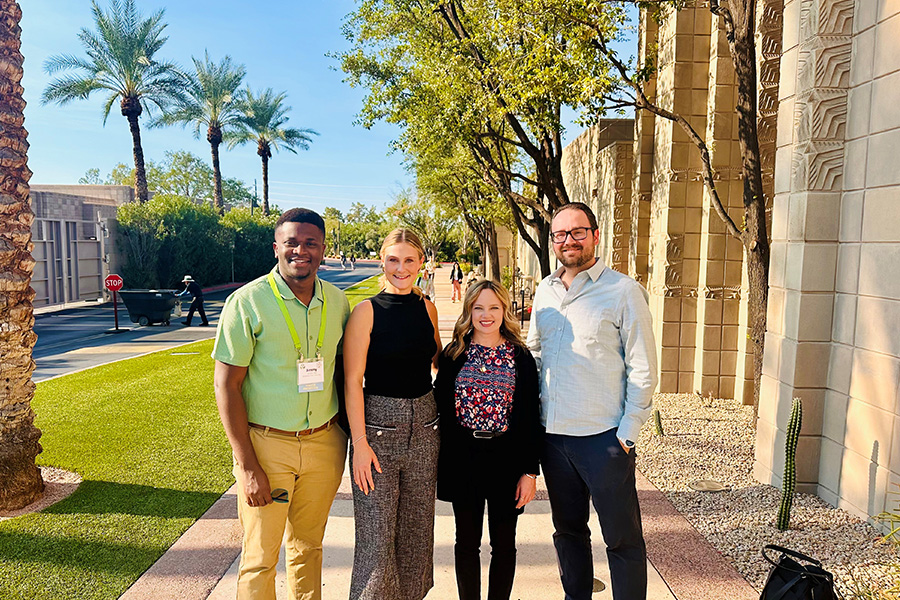
Human Factors and Ergonomics Society showcases versatility of human factors to OSU students
Tuesday, June 10, 2025
Media Contact: Tanner Holubar | Communications Specialist | 405-744-2065 | tanner.holubar@okstate.edu
Human factors engineering is a discipline formed during World War II, shifting the focus of aircraft design to be pilot-centered to reduce accidents. This was when the rapid advancement of technology and humans’ capability to harness that technology met head-on.
Its focus lies in applying physical and cognitive information to how technology is designed to better meet the user's needs. This is a vast spectrum that includes how cellphones are designed to how a military pilot can process the large amount of information at their disposal.
A new student organization within Oklahoma State University’s College of Engineering, Architecture and Technology will help showcase the versatility of human factors to students.
The OSU chapter of the Human Factors and Ergonomics Society was started in spring 2024 as the research of human factors in the School of Industrial Engineering and Management has continued to grow.
Dr. Katie Jurewicz and Dr. Pratima Saravanan are co-faculty advisors of the student group and Matt Nare, a graduate research assistant in IEM, is the group's current president
Nare, the first Ph.D. student recruited by Jurewicz to study human factors at OSU, championed the benefits of having a local HFES chapter.
“We are looking to provide students with additional learning opportunities outside the classroom that will support their academic performance, support their conference readiness and prepare them for pursuing their dream job after graduation,” Nare said. “The presence of an HFES student chapter is something that faculty can use when talking with prospective students about the benefits of pursuing their human factors education at OSU.”
The prime goal of human factors is to ensure systems are designed in the beginning to mitigate any error that occurs due to human-related factors. Jurewicz said many in the field are involved in various areas, including aerospace, defense, health care and even forensics or managing disaster response.
“It's not even just something as simple as designing phones and consumer devices to work for people,” Jurewicz said. “It is any system, any situation, to work for people.”
Currently, there are mechanical and aerospace engineering students who have joined HFES. It is versatile enough to fit with any engineering discipline as well as non-engineering majors.
“Our students come from all majors,” Jurewicz said. “They usually have an interest in making systems better for people. It doesn’t matter what background you come from; you have a place in human factors.”
Now affiliated with the national HFES chapter, OSU students will have access to a network of professionals in human factors, including annual national conferences. These networking opportunities show students how human factors and their discipline can be combined.
“Attending seminars or webinars hosted by HFES allows students to see what other people are doing,” Jurewicz said. “It allows them to see what is out there in industry aside from what is available in academia.”

Jurewicz said she originally wanted to pursue medical school with a goal of helping people. She then learned how human factors engineering can focus on helping healthcare and said learning of what options are available opened more doors for her as a student.
“To see that it is an option is key,” Jurewicz explained. “I look back now, and I would never want to work as a physician in the healthcare system. I would rather be that person who’s taking the high-level view to design the system so doctors and nurses can better do their jobs.
“Patients are not products, but it’s the complete opposite of how you approach every other engineering problem. It’s so challenging to do, but really exciting.”
The group is open to students of any major at OSU. Nare said human factors engineering nicely complements design and merchandising, design, housing and merchandising, computer science, graphic design and biomechanics along with majors such as IEM and MAE.
“Part of the reason I came to OSU was because of conversations with Dr. Jurewicz about her research and where my research interests were and how we could see that research progressing if I came to OSU,” Nare said. “As time goes by, research interests can change and adjust. We’ve been able to make that adjustment and just as our research interests have grown, we have found new ways to adapt human factors because it’s so interdisciplinary, and it can be applied to so many different things that you’re not pigeon-holed into one thing.”
Moving forward, the OSU chapter of HFES will host events throughout the year, including guest speakers, field trips and workshops to support the academic and professional growth of OSU students. There is also a goal to establish relationships with companies willing to allow students to tour their facilities.
Nare said he is pleased a student group has now been formed at OSU, as he knows firsthand the benefits that an HFES chapter can provide students.
“My experience as both a regular member and executive council member of the California State University-Long Beach HFES Student Chapter demonstrated how beneficial a student chapter can be to human factors graduate students and undergraduate students who are interested in human factors by having the opportunity to plan an annual research conference, tour facilities (e.g., an air traffic control center), and network with guest speakers,” Nare said. “Now that the student chapter has been established, I hope it can continue to thrive and support OSU students long after I and the rest of the founding executive council members have graduated.”
Any student wanting to join the OSU chapter of HFES can learn more information by contacting Matt Nare at matthew.nare@okstate.edu or can reach out directly to the student chapter at oklahomastatehfes@gmail.com.
The group is also active on LinkedIn and on Instagram by following @okstatehfes.
